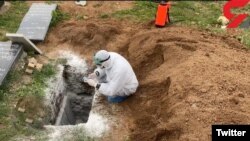An official of Tehran Municipality on Sunday told the members of the City Council that 10,000 new graves are being prepared in the capital's largest cemetery for possible coronavirus victims.
Speaking to the Islamic Republic News Agency (IRNA) on Sunday, Mojtaba Yazdani said isolated facilities for ceremonial washing of bodies before burial were also being installed in crisis shelters previously built on the grounds of the cemetery. Behesht-e Zahra -- Iran's largest cemetery with nearly 1.7 million graves – is located in the south of the capital Tehran and has an area of more than 500 hectares.
According to a member of the City Council bodies of coronavirus victims are buried in two-meter-deep graves with no quicklime but in some Iranian cities the graves and shrouded bodies are dusted with quicklime for disinfection.
Moslems and Jews hasten burial and avoid keeping bodies for too long after death. Iranian cemeteries often have graves prepared for burial which can be used as the need arises. Large patches of empty graves can be found in most cemeteries.
In some Iranian cities special plots have been allocated to COVID-19 victims. Bodies of victims – if possible -- are buried after ceremonial washing and are wrapped in protective layers. In the case of coronavirus victims, particularly in the early days of the outbreak, a carefully formulated procedure known as "dry ablution" was performed instead of washing with water.
Iranian officials have so far not revealed the number of coronavirus victims in the capital and the Province of Tehran, presumably on national security grounds. According to the latest official announcement, 4.470 have died of COVID-19 and 71,686 cases have been identified as of April 12 in the country. Many, including several Iranian lawmakers have expressed doubts in the reliability of Iran's official numbers.
An exclusive independent report by Radio Farda based on statements made by local officials across the country indicated that 142,000 have so far been hospitalized in Iran with COVID-19 symptoms and at least 9,100 died of the disease.









